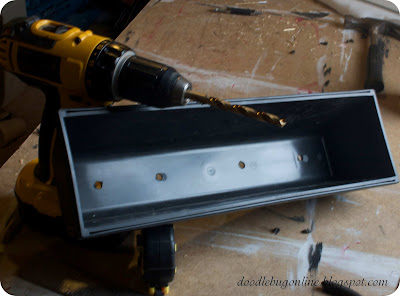Heya everyone! Today is an epic day, you wanna know why? Because I'm about to do something I have never done. I am going to post twice in one day.
Say What???
Yes, believe it and throw a party because it may never happen again.
I have a great project to show you, but it involves two different steps. So I'm splitting it into two posts so that you can easily read only the part you care about, without wading though a post that goes on for miles. "I'm so thoughtful like that!" This post is about how to build a basic wood planter box, the second is how I painted it. I'll explain a little more about why I did it all in the next post, but for now you can just know that this was a birthday present for a friend (and she already got it, so now I am at liberty to show all of you!).
**Update: Check out the next post at Wax-Resist Stenciled Planter**
**Update: Check out the next post at Wax-Resist Stenciled Planter**
Let's get the nitty gritty out of the way first. Here were the materials I started with, (plus a 1"8"x5' pine board).
14" Mud Pan (from the hardware store)
1" All-Purpose Screws
1-1/2" Nails
Drill
Hammer
Clamps
Rope or Cord for handles
First, I prepped the 14" mud pan. This is to act as a liner, so the wood doesn't sit filled with wet soil all the time. First, I took out the metal scraper thingies; then I drilled four holes in the bottom for drainage and two holes in the top at each side to put the rope through and make some cute little handles to pull out the liner for watering. I forgot to take a picture of that part, but you can see the handles in the post Wax-Resist Stenciled Planter.
Now here for your viewing and reading pleasure is...how to build a planter box from basic pine lumber.
Presented in Picture Form. I wish I had a pianist playing, like in a silent film :)
Didja get all that? Here it is in words, for you non-visual learners:
1. Screw the bottom feet to the two bottom pieces, leaving about 1/4" gap in the middle for drainage.
--Make sure to pre-drill the holes so you don't split the wood, and countersink the screws :)
2. Glue and tack the whole piece together with nails. The nails will hold it temporarily while you get it
all put together, but use a lot of glue.
3. To make sure it stays together long term, clamp it all together good and tight. Let that sit for a
couple hours.
4. Take it out of the clamps and sand it.
Voila! Now we're ready to paint! And seriously, don't miss the next post, Wax-Resist Stenciled Planter. I'm pretty excited about this technique and I'm pretty sure this is the only place you're going to find it right now. Here's a teaser:
See you back here in a flash!
~The Doodle Bug
















No comments:
Post a Comment
I love to read your comments and questions!